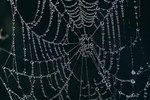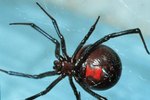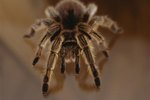
Picture an intricately designed spider web glistening with dew in the morning sun, and you are likely thinking of an orb weaver spider's web. These very common arachnids are found throughout most of the world. Though many people hate spiders, they play an important role in the ecosystem. Rather than fear, orb weavers deserve appreciation for consuming insect pests.
Habitat
Orb weaver, or garden, spiders belong to the family Araneidae. Over 3,500 species of orb weavers have been identified throughout the world, and nearly 200 species are found in North America. They will spin their webs just about anywhere they can find attachment points. Common spots are in plants, between trees, under porch overhangs, on porch lights, on fences and in play equipment left standing in the yard. Garden spiders rarely venture inside human dwellings, though occasionally one might unwittingly travel inside on a potted plant or other item.
Web
The beautifully formed web of an orb spider is a marvel of nature. Most orb weavers spin a new web each night after eating the remnants of the old web. The spider begins by spinning a central vertical thread with a second primary line. This serves as the framework for the web. The spider then spins multiple threads radiating out from the web's center, along with the characteristic threads that give the web its circular appearance. The spider uses the non-sticky "spokes" of the web for walking, while the sticky circular threads serve to capture unwary insects. Web sizes range from a couple of inches to several feet across.
Appearance
Orb weavers are a very diverse group, with a wide range of colors, shapes and sizes. The males are smaller than the females, and most do not spin webs. A typical female garden spider has a large, rounded body with a small head and eight thick legs. Most have stripes, blotches or circles in shades of brown, gray, white or black. Some species have bright patterns in yellow, red, pink or even blue. Other unusual species of garden spiders resemble spiky crabs, and a few have triangular bodies. Garden spiders are not especially aggressive, and usually run if disturbed. Their venom is not strong enough to harm people or pets, and their bite is not exceptionally painful.
Life Cycle
Orb weavers usually mate in the fall. As in many other families of spiders, the female of species in the Araneidae family sometimes eats the male after mating. The female spins an egg sac to hold 100 to 300 eggs, which she attaches underneath a leaf. Both males and females typically die shortly after mating. The baby spiders hatch within a couple of weeks, but remain inside their egg sac until winter is over. Once the tiny spiders emerge from their egg sac in early spring, they make small webs near their birthplace, or disperse on the wind, attached to short lengths of silk.
References
Photo Credits
-
Digital Vision./Digital Vision/Getty Images
Writer Bio
Living in California, Michelle Ullman is a professional writer with particular expertise in home, garden and pet/nature topics. Her work is published on many websites. She loves crafts and has a deep interest in design and DIY projects.



